How to Clean & Care for Block Paved Driveways and Paths
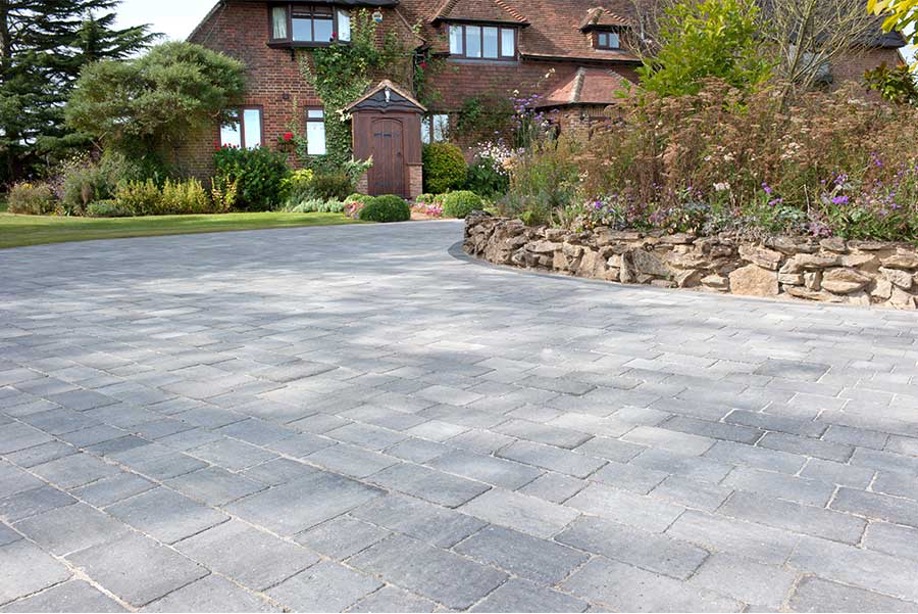
Block paved driveways and paths are a popular choice for homeowners due to their durability and aesthetic appeal. But over time, dirt and moss can accumulate on the surface, and weeds may spring up between blocks. For this reason, keeping your block paving clean and debris-free is essential if you want to maintain its appearance.
Not sure where to start? In this guide, we’ll outline top tips for cleaning block paving, from general maintenance advice to easy stain removal methods. We’ll also touch on ways to help your driveway or path look great for longer, so keep reading to learn more.
What is block paving and what are its benefits?
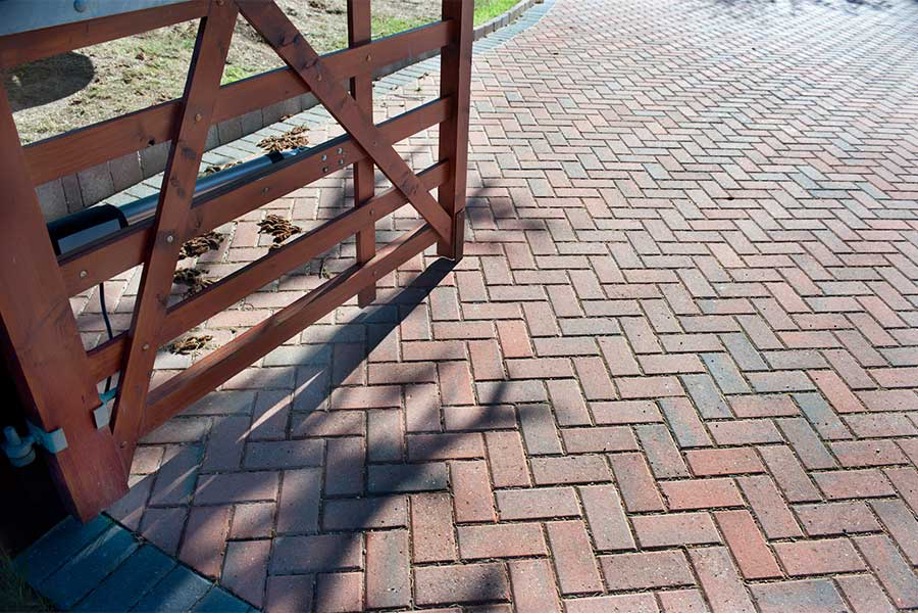
Block paving involves arranging individual blocks – often concrete or natural stone – in a particular pattern to create a hard-standing surface. Popular designs include herringbone, basket weave and stretcher bond patterns, all of which will enhance your home’s kerb appeal.
Once secured in place, the gaps between the blocks are filled in with kiln dried sand or jointing compound. This creates an attractive, sturdy finish and helps to prevent a buildup of debris and weeds. You can also add kerb stones around the paving’s border to neaten the edges.
As well as being more visually appealing than asphalt and larger paving slabs, block paving is also more robust. Not to mention highly resistant to wear and tear. And when pieced together, the blocks can withstand heavy loads and frequent foot traffic – ideal for driveways and paths. In fact, block paving should last for many years, provided it is laid correctly and looked after.
On top of that, if a block becomes damaged or stained, it can be easily replaced. Simply lift out the affected brick and swap it for a new one, without having to redo your entire paving!
Cleaning block paving: general maintenance basics
If you’re wondering how to clean block paving, you’ll be pleased to hear that the process is generally straightforward. Here are the key steps to factor into your maintenance routine.
Brushing
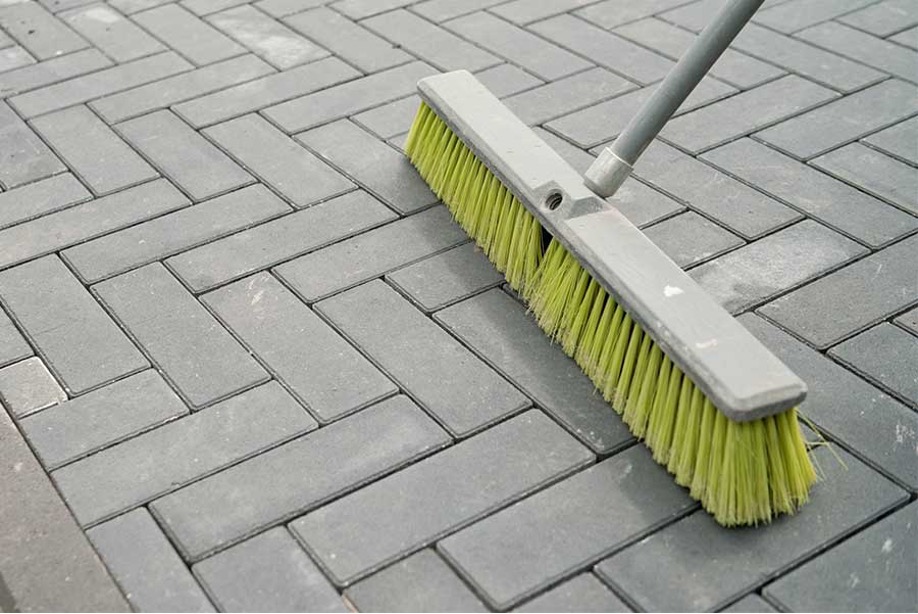
The first stage is to brush your paving with a stiff brush regularly to remove any loose dirt and debris. This will help to prevent grime from gathering in the gaps, while reducing surface stains too. It can also deter weeds from growing, as any seeds won’t have chance to develop.
When brushing, work diagonally inwards from one corner of your driveway to retain as much of the sand between the blocks as possible when sweeping. That way, you shouldn’t need to refill the gaps very often after the first couple of months of bedding in.
Removing weeds
Brushing your block paved drive or path regularly repels moss and weeds as they’ll have less to latch onto. However, you’ll likely still encounter a few weeds here and there. This can make your outdoor space look untidy, so if you do spot any, you’ll want to remove them right away.
The best way to do so is by hand, after rain when the soil is looser. Just be sure to remove the full root to stop it growing back. You can use a hooked weeding tool to make this step easier.
If you find that weeds are a recurring problem, you could try applying weedkiller in the gaps. But you should always read the manufacturer’s instructions beforehand to check it is safe for your block paving material. You should also test it on a discreet area first and look out for any discolouration. Alternatively, a sealant is a more permanent solution which we’ll cover later.
Surface washing
After brushing and removing weeds, it’s time to wash down the surface – this only needs to be done once or twice a year. One technique is to use a washing up liquid solution, but a specially formulated patio cleaning solution is better. Both environment and results wise. For general block paving cleaning, we’d suggest Azpects Easycare Patio & Deck Cleaner:
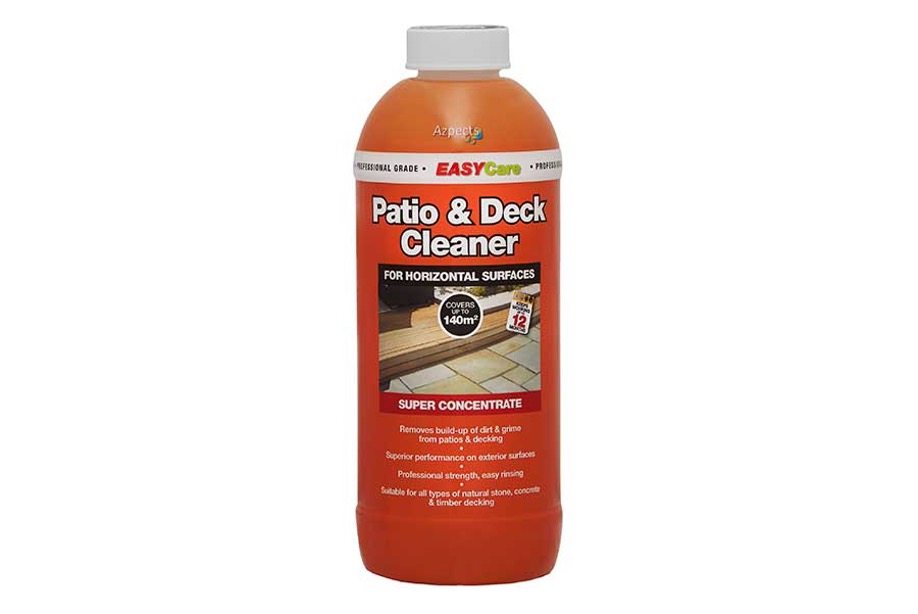
- Dilute 200ml of the concentrated formula in a 5 litre bucket of water and mix well.
- Pour over your driveway in batches, then work diagonally to scrub the surface with a stiff brush and loosen any grime.
- When you’ve done the full surface, leave the sudsy mix on the paving for 20 minutes.
- Once time’s up, rinse well with the hosepipe, then scrub off any leftover residue and push off excess water with a brush.
- Leave to dry, then check if any gaps look low on sand and top them up as needed.
For heavily soiled block paving that needs some extra TLC, upgrade to Azpects Easycare Hardscape Cleaner. This high performance, non-acid cleaner will remove organic soiling from all porous building materials and can be used safely on man-made and natural stone.
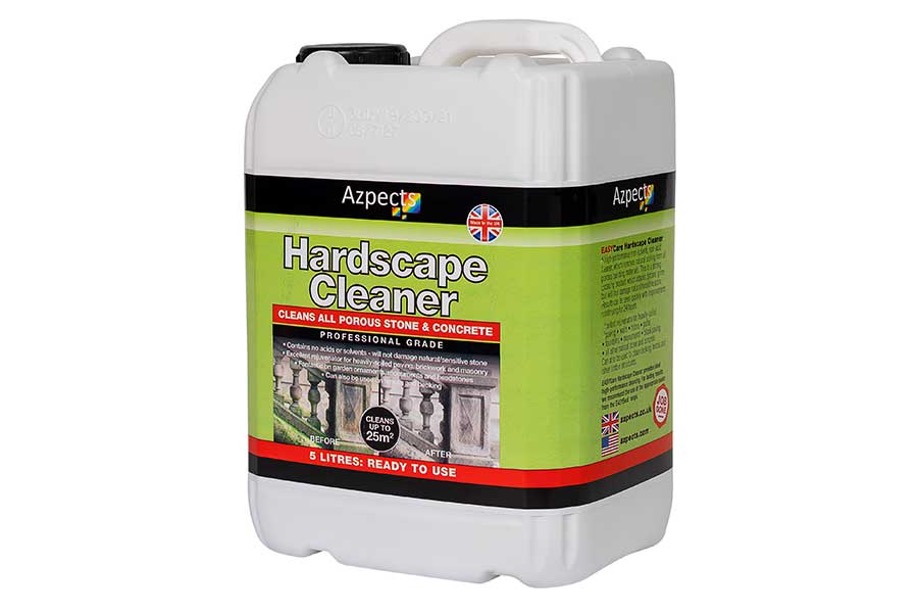
Advice for pressure washing block paving
While it is OK to use a pressure washer to clean heavily soiled block paving it can wash out the sand between blocks and should be done carefully. If a lance attachment is use it should be operated at a low-pressure setting and directed at a 30 degree angle. The best way to use a pressure washer on block paving (and paving slabs), is to use a rotary head cleaning attachment. These are specifically designed for cleaning paving and are less likely to wash away sand between blocks or pointing between paving slabs. It is advisable to first use specific cleaning chemicals which can be washed away with a gentle jet of water from a hosepipe.
Tip: when it comes to new bloc paving, stick to dry brushing for the first month. This will give the sand time to settle and reduce the chances of it being flushed out during cleaning.
How to remove stains or natural deposits from block paving
Cleaning block paving that’s been neglected for some time? Or perhaps you’ve noticed an issue that’s developed since it’s last clean? Whatever the case, we have a suitable product and technique to treat practically every type of block paving staining or organic growth. Let’s dive in…
Moss
Want to kill moss on your block paved driveway? Thankfully, it’s one of the easiest deposits to treat as it doesn’t penetrate paving. Instead, it clings to dirt on the surface – especially where it gathers in the gaps. As such, you can just scrape or scrub it off, then wash and dry the surface. You can also cut back bushes to help prevent it returning as moss thrives in dark, moist areas.
Algae
Another substance that grows in damp, shaded areas is algae, which forms a mouldy green mist on top of your paving. This isn’t quite as easy to remove as moss, but you can typically scrub it off with a 1:1 detergent and water solution. The downside to this is that any surrounding plants may be harmed – and it can fade coloured block paving too. A safer option is Azpects Easycare Paving Algae Remover. Just mix 100ml of the product into 5L of water and brush it onto the surface. There’s no need to rinse it off and you should see results within 24 hours. This product also kills the bacteria which cause the growth to form.
Lichen
If you spot black and white spots when cleaning your block paving, it may well be lichen. Unfortunately, penetrating lichen is stubborn and harder to remove than both moss and algae – but not impossible. Azpects Easycare Paving Black Spot Remover is specially formulated to kill the spores and lift the staining from the surface. Apply a generous layer, leave for 8 hours, then scrub vigorously with a damp brush. Rinse well with a power washer for best results.
Tip: only use power washers for tough block paving cleaning jobs, as they will lift some sand out of the gaps. Adjust the nozzle to a 30° angle and work diagonally to minimise the loss.
Efflorescence
Spotted a white fluffy layer on top of your block paving? If it’s only recently been laid, chances are you’ve got a case of efflorescence. This is a natural phenomenon caused by salt deposits in the concrete dissolving and rising to the surface after rain. It is common in new paving and brickwork, the problem lessens over time as salt levels decline through natural weathering.
In many cases, efflorescence can simply be brushed off with a stiff brush. But if you want to speed up the process, you could opt to neutralise the salts. Azpects Easycare Efflorescence Remover is ideal for this and will reduce the likelihood of the visible residue coming back.
Oil stains
If you park a car on your block paved driveway, there’s potential for oil spillages or leaks. Likewise, if you use a BBQ on a block paved patio, greasy substances can leach into the stone. You may not even notice them at first, but over time, the stain will become more visible.
To treat, dampen the surface and apply Azpects Easycare Grease & Oil Away Cleaner neat. Agitate with a stiff brush, then leave for 15 minutes before applying a second coat. Wait another 15 minutes, then scrub and rinse well with warm water to break down any leftover oil.
Rust stains
Azpects also offer a similar product for treating rust stains, which you only need to apply once. So if you notice telltale orange-hued staining – often caused by old drainpipes, garden furniture or even aging vehicles – don’t panic. Simply dampen the area, apply this, then scrub to remove.
How to re-sand block paving after cleaning
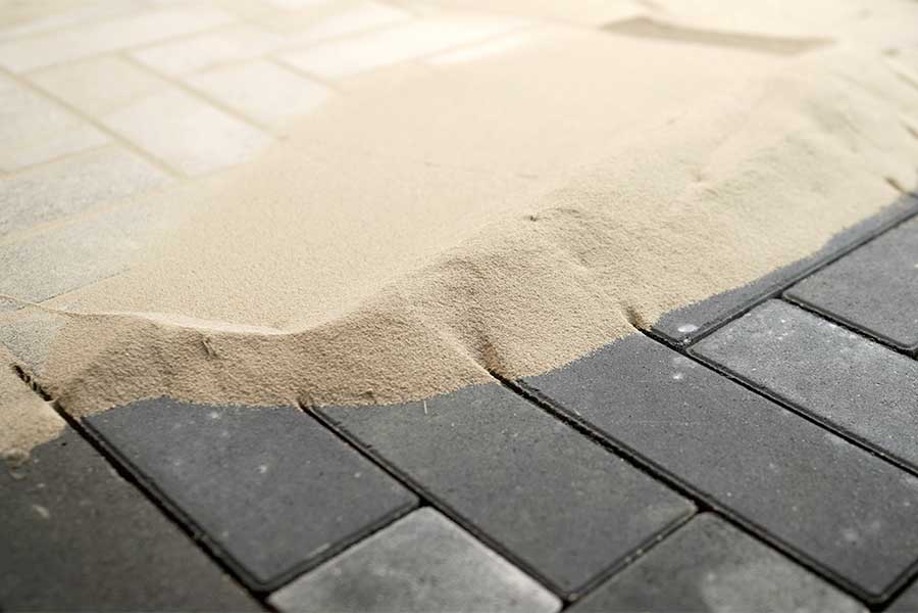
Whatever method you use for cleaning block paving, you’ll no doubt rinse or brush out some of your paving’s jointing sand. But don’t worry, the process for adding new sand is simple.
After cleaning, leave your driveway or path to dry completely before applying the sand. You should also check the weather forecast – you’ll need a largely dry day to prevent clumping.
To apply, simply spread kiln-dried sand onto the surface and use a stiff bristle brush to push it into the gaps. This extra fine sand’s lack of moisture makes it highly resistant to freeze-thaw –perfect for creating robust drives, patios and paths.
Once you’ve done one full sweep of the paving, check for any joints that look a little low and apply more sand as needed. Next, run a softer brush over the surface to remove any excess. Finish by lightly misting the joints to help the sand bind and stay in place if windy.
Tip: for most block pavers, you’ll need around 1kg of sand per 1sq metre and more if rounded.
How do you seal block paving?
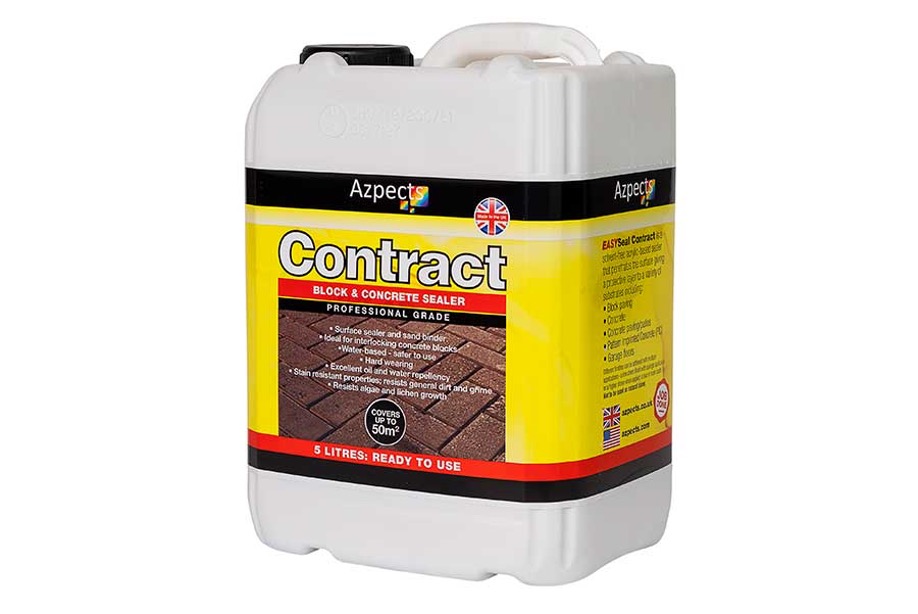
When you seal block paving, you are adding a transparent, protective layer over the pavers which repels weeds and stains. The low sheen will also enhance the paving’s surface colour and extend the life of the concrete by penetrating deep into the substrate, protecting from frost and weathering. All in all, you will benefit from a low maintenance and attractive finish for minimal effort. So how do you seal block paving?
- Start by brushing off any dirt, then ensure the joints are full and the sand is well compacted. If you’re happy that the surface is clean and everything looks good, you can get started on sealing it
- One of the best block paving sealer products you can use is Azpects solvent-free Easyseal Contract Block & Concrete Sealer. Apply an even coat of sealant with a long-handled paint roller or a pressure sprayer.
- If using the former, roll on at right angles, but work diagonally across the joints if using a sprayer. Just remember to mop up any excess liquid as you go – there should be no obvious pooling.
- Leave the first coat to dry for around 1 hour, then apply a second coat to seal porous blocks. This will create an upmarket low sheen finish on your block paving.
- After 24 hours, the sealant should be dry enough to walk on or park your car safely.
It’s as simple as that! However, one key thing to note is that you should only apply sealant once the paving has fully settled. This is usually around 6 months after installation.
The reason for this is because you need to give any efflorescence and similar mineral deposits the opportunity to escape through the surface before it is sealed. Otherwise, you could trap the natural salts in the blocks, resulting in the development of a white residue that can’t be washed off. And that, of course, would negatively impact the finished result – permanently.
Find essentials for sealing & cleaning block paving at AWBS
Whether you’re looking to refresh an established block paved driveway or seal a recently laid one, we have everything you need. Browse a range of high quality paving care products online. Plus 25kg bags of kiln dried sand and decorative path edging stones. Or if you’re not sure what you need, visit us in branch to get expert advice from our team.
Our sister company Oxford Garden Centre also stocks plenty of garden tools that may come in handy. Especially when it comes to weed and debris removal, so check them out too.
Either way, we can provide fast and free delivery to addresses in Oxford, Yarnton and Swindon. And there’s no minimum order value either! Check your eligibility online now.


